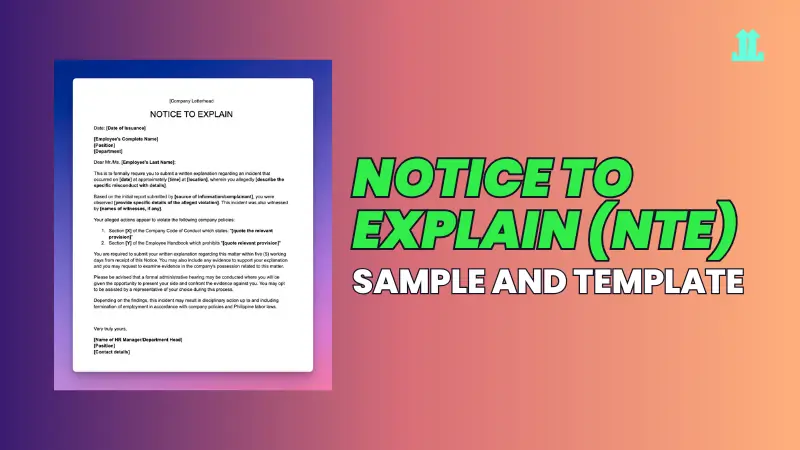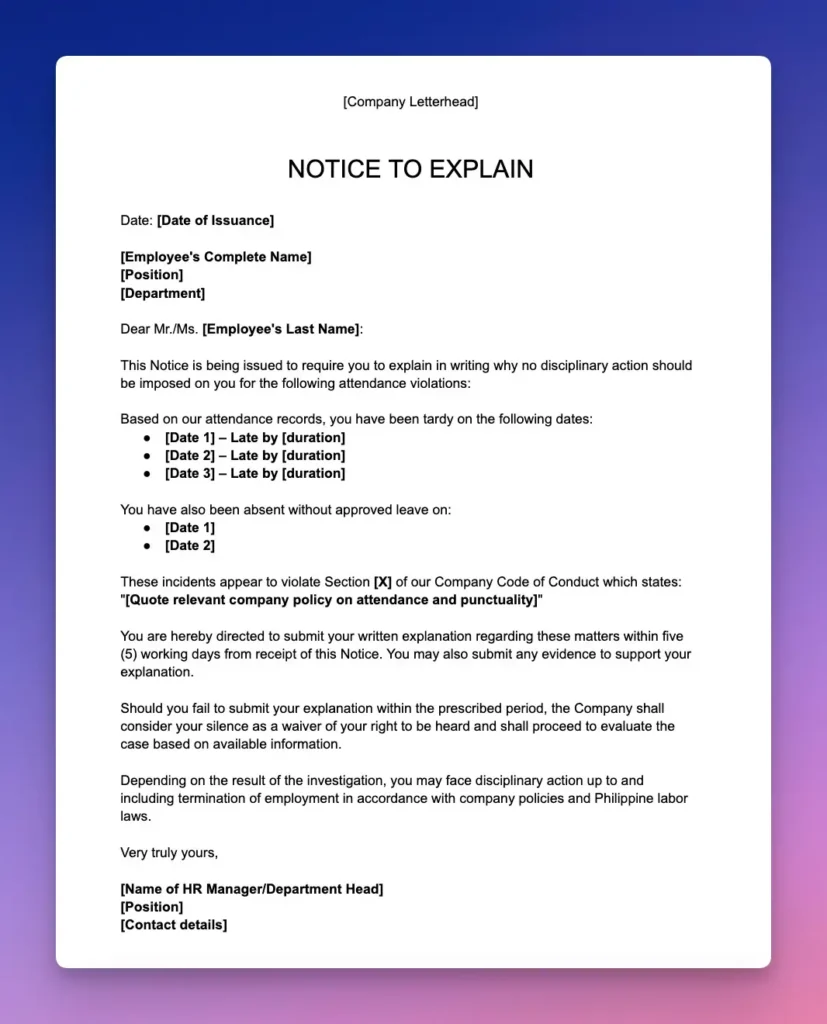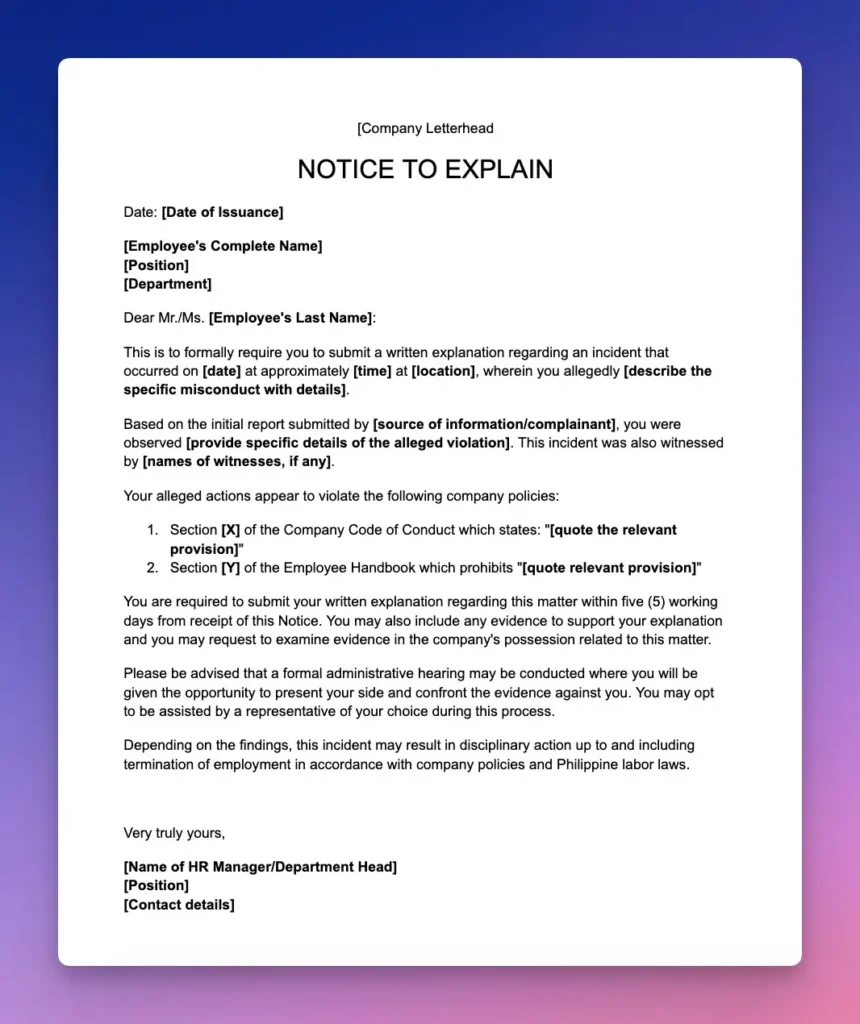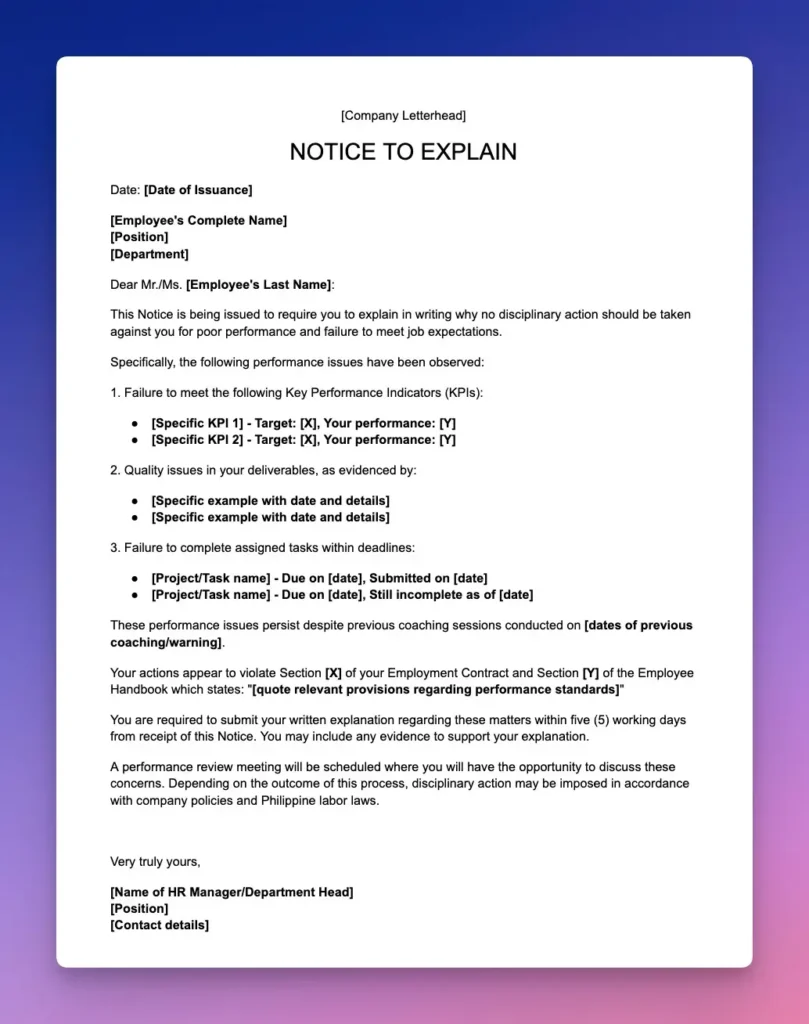Notice to Explain (NTE): Sample Templates, Requirements, and Best Practices in the Philippines
A Notice to Explain (NTE) is a formal written document issued by employers to employees in the Philippines when there…

A Notice to Explain (NTE) is a formal written document issued by employers to employees in the Philippines when there are allegations of misconduct or policy violations that may warrant disciplinary action.
This document serves as the first step in the procedural due process mandated by Philippine labor laws, giving employees a fair opportunity to present their side before any disciplinary measures are imposed.
In the Philippine employment context, the NTE plays a crucial role in upholding due process in disciplinary cases. It protects both the employer’s right to maintain workplace discipline and the employee’s right to fair treatment.
You might be interested with our other templates:
Under the Labor Code of the Philippines and Department of Labor and Employment (DOLE) Department Order No. 147-15, employers must follow proper procedures when addressing workplace infractions.
Proper NTE documentation is essential not only for legal compliance but also for maintaining harmonious employer-employee relations. Failure to issue a properly formatted NTE or follow due process can result in claims of illegal dismissal, potential reinstatement with backwages, and damage to company reputation.
Key takeaways:
- The NTE must contain specific details about alleged violations
- Both parties should maintain thorough documentation
- Timelines must be reasonable and clearly communicated
- The process must follow the two-notice rule established by jurisprudence
- Consistency and fairness in implementation are essential
Sample Notice to Explain Templates
Template 1: NTE for Attendance/Tardiness Issues

Outlined below is a sample Notice to Explain (NTE) for attendance or tardiness issues. You can also download the notice to explain sample by clicking the download button below.
[Company Letterhead]
NOTICE TO EXPLAIN
Date: [Date of Issuance]
[Employee’s Complete Name]
[Position]
[Department]
Dear Mr./Ms. [Employee’s Last Name]:
This Notice is being issued to require you to explain in writing why no disciplinary action should be imposed on you for the following attendance violations:
Based on our attendance records, you have been tardy on the following dates:
- [Date 1] – Late by [duration]
- [Date 2] – Late by [duration]
- [Date 3] – Late by [duration]
You have also been absent without approved leave on:
- [Date 1]
- [Date 2]
These incidents appear to violate Section [X] of our Company Code of Conduct which states: “[Quote relevant company policy on attendance and punctuality]”
You are hereby directed to submit your written explanation regarding these matters within five (5) working days from receipt of this Notice. You may also submit any evidence to support your explanation.
Should you fail to submit your explanation within the prescribed period, the Company shall consider your silence as a waiver of your right to be heard and shall proceed to evaluate the case based on available information.
Depending on the result of the investigation, you may face disciplinary action up to and including termination of employment in accordance with company policies and Philippine labor laws.
Very truly yours,
[Name of HR Manager/Department Head]
[Position]
[Contact details]
Received by:
______________________________________ ___________________
[Employee’s Signature over printed Name] [Date]
Template 2: NTE for Misconduct or Policy Violations

Outlined below is a sample Notice to Explain (NTE) for misconduct or policy violations. You can also download the notice to explain sample by clicking the download button below.
[Company Letterhead]
NOTICE TO EXPLAIN
Date: [Date of Issuance]
[Employee’s Complete Name]
[Position]
[Department]
Dear Mr./Ms. [Employee’s Last Name]:
This is to formally require you to submit a written explanation regarding an incident that occurred on [date] at approximately [time] at [location], wherein you allegedly [describe the specific misconduct with details].
Based on the initial report submitted by [source of information/complainant], you were observed [provide specific details of the alleged violation]. This incident was also witnessed by [names of witnesses, if any].
Your alleged actions appear to violate the following company policies:
- Section [X] of the Company Code of Conduct which states: “[quote the relevant provision]”
- Section [Y] of the Employee Handbook which prohibits “[quote relevant provision]”
You are required to submit your written explanation regarding this matter within five (5) working days from receipt of this Notice. You may also include any evidence to support your explanation and you may request to examine evidence in the company’s possession related to this matter.
Please be advised that a formal administrative hearing may be conducted where you will be given the opportunity to present your side and confront the evidence against you. You may opt to be assisted by a representative of your choice during this process.
Depending on the findings, this incident may result in disciplinary action up to and including termination of employment in accordance with company policies and Philippine labor laws.
Very truly yours,
[Name of HR Manager/Department Head]
[Position]
[Contact details]
Received by:
_________________________ ___________________
[Employee’s Signature over printed Name] [Date]
Template 3: NTE for Performance-Related Concerns

Outlined below is a sample Notice to Explain (NTE) for performance-related concerns. You can also download the notice to explain sample by clicking the download button below.
[Company Letterhead]
NOTICE TO EXPLAIN
Date: [Date of Issuance]
[Employee’s Complete Name]
[Position]
[Department]
Dear Mr./Ms. [Employee’s Last Name]:
This Notice is being issued to require you to explain in writing why no disciplinary action should be taken against you for poor performance and failure to meet job expectations.
Specifically, the following performance issues have been observed:
1. Failure to meet the following Key Performance Indicators (KPIs):
• [Specific KPI 1] – Target: [X], Your performance: [Y]
• [Specific KPI 2] – Target: [X], Your performance: [Y]
2. Quality issues in your deliverables, as evidenced by:
• [Specific example with date and details]
• [Specific example with date and details]
3. Failure to complete assigned tasks within deadlines:
• [Project/Task name] – Due on [date], Submitted on [date]
• [Project/Task name] – Due on [date], Still incomplete as of [date]
These performance issues persist despite previous coaching sessions conducted on [dates of previous coaching/warning].
Your actions appear to violate Section [X] of your Employment Contract and Section [Y] of the Employee Handbook which states: “[quote relevant provisions regarding performance standards]”
You are required to submit your written explanation regarding these matters within five (5) working days from receipt of this Notice. You may include any evidence to support your explanation.
A performance review meeting will be scheduled where you will have the opportunity to discuss these concerns. Depending on the outcome of this process, disciplinary action may be imposed in accordance with company policies and Philippine labor laws.
Very truly yours,
[Name of HR Manager/Department Head]
[Position]
[Contact details]
Received by:
_________________________ ___________________
[Employee’s Signature over printed Name] [Date]
Template 4: Notice to Explain Response Format
If you’re the receiving end of the NTE, here’s a sample NTE response that you can use. You may copy and paste the document below or download the .docx document.
[Date]
[Addressee’s Name]
[Position]
[Company Name]
[Address]
RE: Response to Notice to Explain dated [date of NTE]
Dear Mr./Ms. [Last Name]:
I am writing in response to the Notice to Explain dated [date] regarding [brief description of the alleged violation].
After carefully reviewing the allegations, I would like to provide the following explanation:
[Provide a clear, factual account of your side, addressing each allegation specifically]
To support my explanation, I am attaching the following documents:
- [Document description]
- [Document description]
- [Document description]
I believe the above explanation and supporting documents clarify the circumstances of the incident. I hope this helps in your fair evaluation of the matter.
I remain committed to my responsibilities and to upholding company policies. Should you require any additional information, I am willing to discuss this matter further.
Respectfully yours,
[Your Signature]
[Your Printed Name]
[Position]
[Contact Information]
Essential Components of a Valid Notice to Explain
Required Elements with Explanations
A legally compliant NTE in the Philippines must contain these essential components:
- Complete employer identification: Company name, address, and contact information
- Employee information: Full name, position, department
- Date of issuance: When the NTE is being issued
- Clear statement of allegations: Specific details of the alleged infractions
- Reference to company policies: Citing specific rules allegedly violated
- Request for explanation: Clear instruction to submit a written explanation
- Response timeframe: Reasonable period (typically 5 working days) for response
- Administrative details: Information about investigation proceedings
- Possible consequences: Potential disciplinary actions if allegations are proven true
- Signature block: For both the issuer and the employee receiving the notice
Importance of Specificity in Allegations
The allegations must be detailed enough to inform the employee exactly what they’re being accused of. Vague statements like “violation of company policies” are insufficient. Instead, specify:
- What: Exact nature of the violation
- When: Date and time of the incident
- Where: Location of the incident
- How: Manner in which the violation occurred
- Which: Specific company policy or rule violated
This specificity is not just a legal requirement but also helps focus the discussion and ensures fair evaluation of the employee’s explanation.
Proper Delivery and Receipt Methods
Proper service of the NTE is crucial for its validity. Acceptable methods include:
- Personal service: Directly handing the document to the employee
- Registered mail: Sending through registered mail to the employee’s last known address
- Email: Sending to the employee’s official work email (with receipt confirmation)
Regardless of the method, employers must maintain proof of delivery such as:
- Signed acknowledgment receipts
- Return cards from registered mail
- Delivery confirmation for electronic notices
Common Mistakes That Could Invalidate an NTE
Several errors can render an NTE legally defective:
- Vague allegations: Failing to provide specific details of the alleged misconduct
- Insufficient response time: Not allowing reasonable time (usually 5 working days) for explanation
- Predetermining guilt: Language that presumes guilt before hearing the employee’s side
- Improper delivery: Failing to properly document service of the notice
- Missing reference to company policies: Not citing specific policies allegedly violated
- Intimidating language: Using threatening or coercive language
These mistakes can lead to claims of procedural defects and potentially invalidate any subsequent disciplinary action.
Formatting Guidelines and Legal Language
When preparing an NTE in the Philippines, follow these formatting guidelines:
- Use company letterhead with complete business information
- Keep language formal but clear, avoiding technical jargon
- Maintain a neutral tone, avoiding accusatory language
- Number paragraphs or sections for easy reference
- Include Filipino translations of key terms if necessary for clearer understanding
- Use proper salutations and closings as per Philippine business practice
- Include spaces for signatures and dates to acknowledge receipt
Legal terms commonly used in Philippine NTEs include:
- “Administratively charged”
- “Gross negligence”
- “Willful disobedience”
- “Loss of trust and confidence”
- “Prejudicial to the interest of the company”
Step-by-Step Guide to Writing an Effective NTE
Drafting Instructions
- Identify the specific infraction with details of what happened, when, where, and how.
- Gather preliminary evidence to ensure there’s a reasonable basis for issuing the NTE.
- Review company policies to identify which specific rules were allegedly violated.
- Use the appropriate template based on the nature of the infraction.
- Customize the template with specific details of the case.
- Have legal or HR review the draft for compliance with labor laws.
- Prepare multiple copies for the employee, HR files, and delivery documentation.
- Sign the notice by an authorized company representative.
Documenting Proper Delivery
Proper documentation of NTE delivery is crucial for legal compliance:
- Prepare an acknowledgment receipt form for the employee to sign.
- If delivered in person:
- Have the employee sign and date the acknowledgment receipt
- If the employee refuses to sign, have a witness document the refusal
- Provide the employee with their copy regardless of signature
- If delivered via registered mail:
- Keep mailing receipts and tracking information
- File the return card when received
- Document the date of actual or presumed receipt
- If delivered electronically:
- Use company email with read receipts
- Follow up with confirmation of receipt
- Print and file email delivery confirmations
Timeframes for Response
Philippine law and jurisprudence have established reasonable timeframes for the NTE process:
- Response period: 5 working days is standard, but complex cases may warrant longer periods
- Administrative hearing: Should be scheduled within a reasonable time after receiving the explanation
- Decision issuance: Should be made within a reasonable time after the hearing
These timeframes should be clearly communicated in the NTE to ensure the employee understands the process timeline.
Post-NTE Proceedings
After issuing the NTE, employers should follow these steps:
- Document receipt of explanation with date and time
- Review the explanation thoroughly and objectively
- Conduct administrative hearing if necessary:
- Inform the employee of the schedule and format
- Allow the employee to present evidence and witnesses
- Document the proceedings with minutes
- Permit representation if requested
- Evaluate all evidence impartially
- Determine appropriate action based on company policies and the gravity of the offense
- Issue the second notice (Notice of Decision) detailing the findings and any disciplinary action
FAQ
How many days does an employee have to respond to an NTE in the Philippines?
The standard timeframe is 5 working days from receipt of the notice. However, for complex allegations or special circumstances, employers may provide additional time.
Is an NTE required before any disciplinary action?
Yes, for serious infractions that may lead to suspension or termination. Under Philippine law, particularly as established in the King of Kings Transport case, the NTE is a mandatory component of due process for major disciplinary actions.
Can an employer terminate an employee immediately after issuing an NTE?
No. After issuing an NTE, employers must:
1. Wait for the employee’s explanation
2. Conduct an investigation and/or hearing
3. Evaluate all evidence fairly
4. Issue a Notice of Decision
Immediate termination without following these steps would constitute illegal dismissal under Philippine law.
What happens if an employee refuses to receive or sign the NTE?
If an employee refuses to receive or sign an NTE when delivered in person, the employer should:
1. Have the incident witnessed by at least two company representatives
2. Prepare a written record of the refusal signed by the witnesses
3. Send the NTE via registered mail to the employee’s last known address
4. Document all attempts at delivery
Refusal to receive or sign does not invalidate the notice if proper documentation of the attempt exists.
How specific must the allegations be in an NTE?
Allegations must be highly specific, including:
1. Exact dates and times
2. Precise description of the alleged misconduct
3. Specific company policies violated
4. Names of witnesses (where appropriate)
5. Details of how the violation occurred
The Supreme Court has consistently invalidated vague or general allegations as violations of due process.
What remedies does an employee have if termination occurs without proper NTE?
If termination occurs without proper NTE or due process, an employee can:
1. File a complaint with DOLE’s SEnA for initial conciliation
2. File an illegal dismissal case with the NLRC
3. Seek reinstatement with full backwages and benefits
4. Claim damages and attorney’s fees
Under Philippine jurisprudence, dismissal without due process may be declared illegal even if there was just cause for termination.
Conclusion
Properly issuing a Notice to Explain is a critical step in ensuring due process in employee discipline cases in the Philippines. Both employers and employees benefit from understanding the legal requirements and best practices surrounding this important document.
For employers, following the proper procedures not only ensures legal compliance but also promotes a culture of fairness and transparency. Cutting corners in the disciplinary process can lead to costly legal battles, damaged employee relations, and potential liability for backwages and damages.
For employees, understanding your rights when receiving an NTE allows you to respond appropriately and protect your interests. The right to due process is fundamental in Philippine labor law and should be exercised responsibly.





